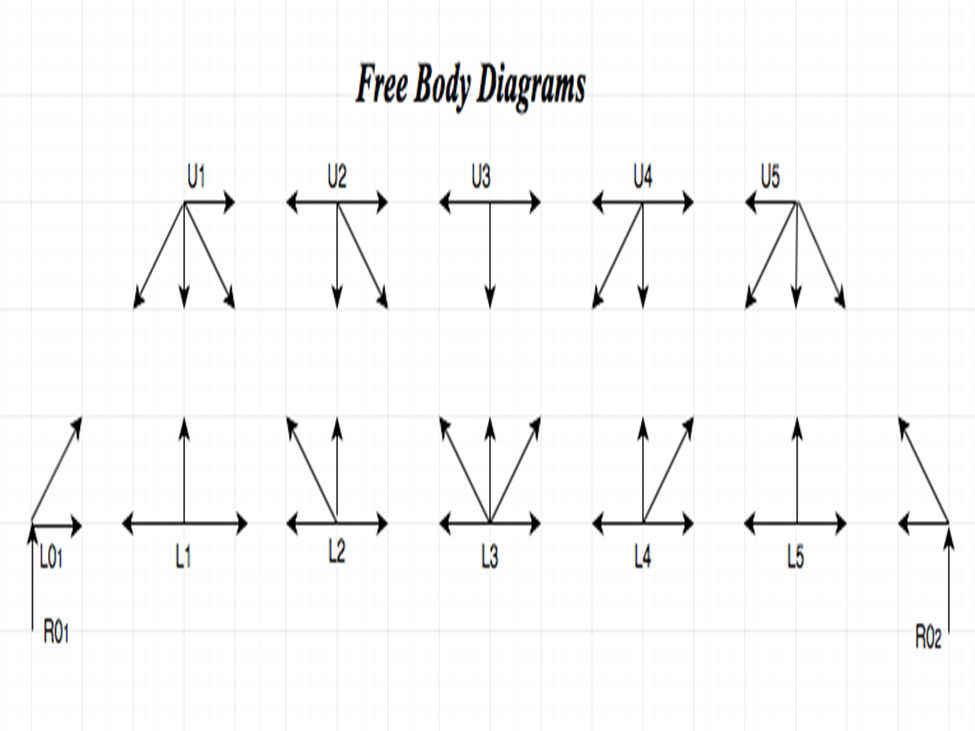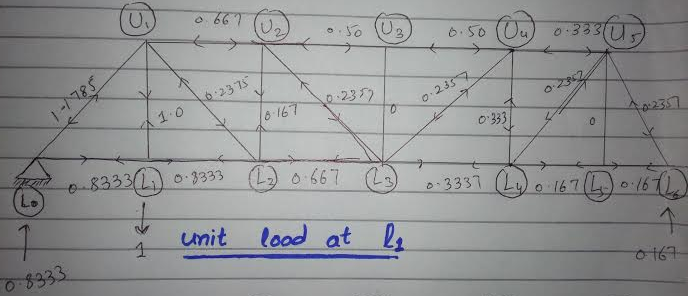mechanics statics project
MECHANICS 1- Statics
Project: Truss Analysis Under Moving Load
Introduction:
Trusses are defined as structures composed of slender bars connected to each other through pins at their end points. Trusses are used in the construction of nearly every bridge you will encounter in any city and highway system. The three main types of trusses used in bridge design are Pratt, Warren and Howe. Truss type differs only by the manner and angle in which the members are connected at joints. In this project, we are given a simple truss system with the loadings on the bridge deck being transferred to the stringers. These stringers are used to transfer the load to the floor beams, and then to the joints along the bottom chord of the truss.
Problem Statement:
When using the method of joints, if a truss is in equilibrium then all of joints must also be in equilibrium. With this bridge, we thought it was important to apply the joint method. firstly, asked to place a unit load at joint L1 and then determine the force in each member of the truss. Then we must move the unit load to L3 and find the force in each member in each case. We will get it correct with the joint method and finding forces at every point then checking the answers by the two member section method
Assumptions:
The truss members are connected at their ends only
Truss is only loaded at joints
Weight of truss members are suffering from the proper care, compared to the load acting on the truss.
Variables:
L0, L1, L2, L3, L4, L5, L6
U1, U2, U3, U4, U5
R0, R1
Calculation Manual:
| Forces at | |||||||
| L0 | L1 | L2 | L3 | L4 | L5 | L6 | |
| L0L1 | 0 | 0.833 | 0.667 | 0.5 | 0.333 | 0.1678 | 0 |
| L1L2 | 0 | 0.833 | 0.667 | 0.5 | 0.333 | 0.1678 | 0 |
| L2L3 | 0 | 0.666 | 1.333 | 1.0 | 0.6667 | 0.3336 | 0 |
| L3L4 | 0 | 0.333 | 0.667 | 1.0 | 1.3333 | 0.6667 | 0 |
| L4L5 | 0 | 0.167 | 0.333 | 0.5 | 0.6667 | 0.8333 | 0 |
| L5L6 | 0 | 0.167 | 0.333 | 0.5 | 0.6667 | 0.8333 | 0 |
| U1U2 | 0 | -0.667 | -1.333 | -1 | -0.6667 | -0.333 | 0 |
| U2U3 | 0 | -0.5 | -1 | -1.5 | -1.0 | -0.50 | 0 |
| U3U4 | 0 | -0.5 | -1 | -1.5 | -1.0 | -0.50 | 0 |
| U4U5 | 0 | -0.333 | -0.667 | -1 | -1.333 | -0.6667 | 0 |
| L0 U1 | 0 | -1.178 | -0.943 | -0.7071 | -0.4714 | -0.2357 | 0 |
| L1 U1 | 0 | 1 | 0 | 0 | 0 | 0 | |
| L2 U1 | 0 | -0.235 | 0.943 | 0.7071 | 0.4714 | 0.2357 | 0 |
| L2 U2 | 0 | 0.167 | 0.333 | -0.50 | -0.3333 | -0.3333 | 0 |
| L3 U2 | 0 | -0.235 | -0.471 | 0.7071 | 0.4714 | 0.2357 | 0 |
| L3 U3 | 0 | 0 | 0 | 0 | 0 | 0 | 0 |
| L3 U4 | 0 | 0.235 | 0.471 | 0.7071 | -0.4714 | -0.2357 | 0 |
| L4 U4 | 0 | -0333 | -0.333 | -0.50 | 0.3333 | 0.167 | 0 |
| L4 U5 | 0 | 0.235 | 0.471 | 0.7071 | 0.9428 | -0.2357 | 0 |
| L5 U5 | 0 | 0 | 0 | 0 | 0 | 1 | 0 |
| L6 U5 | 0 | -0.235 | -0.471 | -0.7071 | -0.9428 | -1.1785 | 0 |
Alternatives:
Alternatively, some other methods that can be used are:
Joint method.
Section method.
All Drawings:
Free body diagrams (Sketch):


Free body diagrams (Computerized Sketch):

Sketch (Unit load a L1, L2, & L3):


Computerized sketch (Unit Load at L1, and L3):
Load at L1:

Load at L3:

Conclusion:
Thus, we found out that any physical structure like bridges and other structures alike can be accurately solved or analyzed using joint method. Other methods like the section method and graphical approach can also be used to do the same analysis but under same assumptions as mentioned earlier. This project tuned our skills as upcoming engineers and helped shaped us in becoming more experienced students when dealt with the task of an engineering project. We got good teamwork practice, which is always a good tool to practice considering we will all hopefully be a part of an engineering firm after college.
References:
http://www.engineersdaily.com/2011/01/3-methods-for-truss-analysis.html
http://www.mathalino.com/reviewer/engineering-mechanics/method-sections-analysis-simple-trusses
http://www.learnengineering.org/2013/08/truss-analysis-method-of-joints.html
Course book.
Lecture slides.
10



